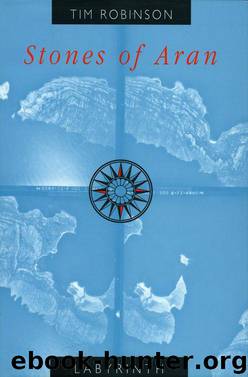Stones of Aran by Tim Robinson

Author:Tim Robinson
Language: eng
Format: mobi, epub
Tags: (¯`'•.¸//(*_*)\\¸.•'´¯)
ISBN: 9781843512844
Publisher: The Lilliput Press
Published: 2012-05-08T14:00:00+00:00
THE BLOOD OF THE HEART
Long ago, as I have been told by one of the elders of the village, a man from Fearann an Choirce travelled as far as Athenry looking for a calf with the makings of a good cow. When he had been walking about that neighbourhood all day, he met a woman carrying a wooden firkin of water and asked her if she would give him a drink of it. “Gladly,” she replied, “And I guarantee you never drank better, unless you ever tasted the water of Tobar Ghrióir in Árainn.” “Why!” said the islander, “That’s the water I’ve been making my tea on all my life!”
Tobar Ghrióir, Gregory’s well, the pride, the very source itself, of the village, is under the scarp of An Scairbh where the road twists north to climb down it. The villagers revert to its water when the piped supply fails for some mechanical reason or tastes salty after a gale; I have filled many a bucket there myself, when helping out at the nearby guest-house, Gilbert Cottage. After long droughts the flow is a mere seepage, but if you pluck one of the stiff fronds of hart’s-tongue fern that grow by it, fold it lengthwise and jam it into a crack of the wet rock-face, water will come rolling off its point like pearls off a broken thread. There are two stone-lined troughs built against the foot of the scarp, a long one to which beasts wandering the road have access, and a small one reserved for humans, defended by a little wall with a stile in it and tucked into the corner between the scarp and the ramp of the road. A fool washed out an oil-barrel in it once, and Bríd Gillan, an outspoken octogenarian living nearby, took a can of white paint and wrote on the rock-face above it, “God gave us this well—keep it clean.” Twelve years later, I notice, just enough of this lettering shows through the mosaic of mosses, lichens and ferns to give the rock an air of cryptic significance.
Water, shelter, a little soil from the shale-band—the usual “givens” of the scarp faces, the usual narrow dispensation of natural treasures—have been repaid by generations of unstinted labour here, so that the village, starting at the foot of the slope by the well and accompanying the road westwards for a few hundred yards, is a green respite from the grey barrenness above and below it. The cottages and houses and bungalows are interspersed with hayfields, potato-plots and pastures, nearly all of them on what is called “reclaimed land.” (The term “reclamation” seems to imply the winning back of something lost, but if anyone ever squandered aboriginal soil here it must have been a thousand or two thousand years ago.) Stócáil (“to stoke” or “to prepare,” according to the dictionaries) is the local word for the process of making fertile land out of bare or nearly bare rock. The method is as follows. First the plot is cleared of loose blocks, which are piled into stacks or used to build walls.
Download
This site does not store any files on its server. We only index and link to content provided by other sites. Please contact the content providers to delete copyright contents if any and email us, we'll remove relevant links or contents immediately.
Annapurna by Maurice Herzog(2846)
Liar's Poker by Michael Lewis(2818)
A Forest Journey by John Perlin(2588)
Atlas Obscura by Joshua Foer(2351)
Cuba by Lonely Planet(2190)
The Ogre by Doug Scott(2118)
Photographic Guide to the Birds of Indonesia by Strange Morten;(2091)
Tokyo by Rob Goss(2022)
All Things Reconsidered by Bill Thompson III(1963)
A TIME OF GIFTS by Patrick Leigh Fermor(1851)
DK Eyewitness Top 10 Travel Guides Orlando by DK(1818)
Abbey in America by Murray John A(1802)
Fatal Storm by Rob Mundle(1792)
The Splendid and the Vile by Erik Larson(1790)
Trail Magic by Trevelyan Quest Edwards & Hazel Edwards(1762)
INTO THE WILD by Jon Krakauer(1730)
Top 10 Dubai and Abu Dhabi by DK Travel(1719)
Touching the Void by Joe Simpson(1713)
Lonely Planet Australia by Lonely Planet(1679)
